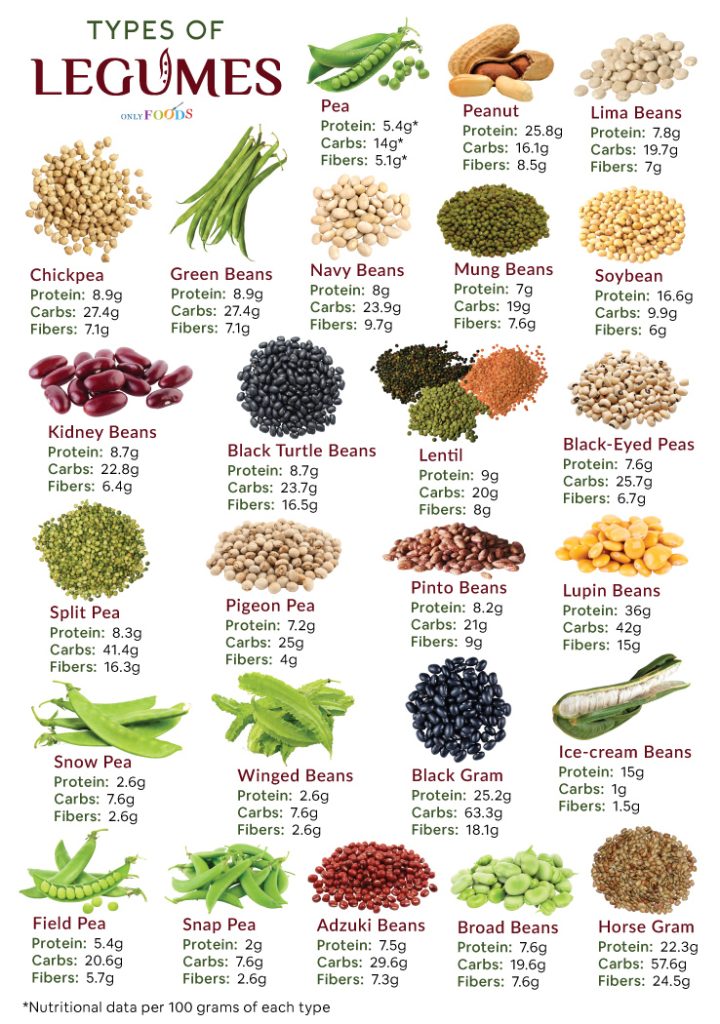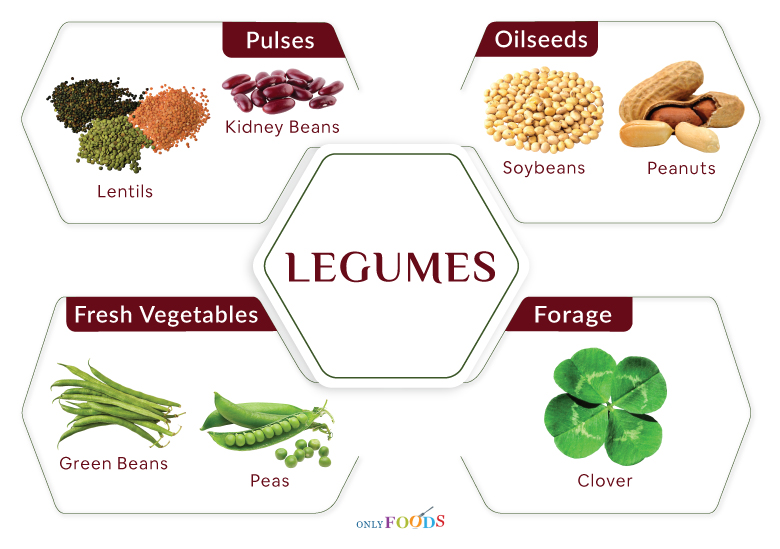Legumes
The family Fabaceae, also known as Leguminosae, includes over 20,000 plants, all of which are recognized as legumes. Many of these plants produce edible fruits and seeds, which are eaten both fresh as vegetables and dried as staples. Additionally, the seeds and pods of numerous legume plants serve as valuable animal fodder. In culinary terms, the legume category spans a wide range, including familiar items like peas and green beans, as well as staples like soy and navy beans.
List of the Most Familiar and Commonly Consumed Varieties of Legumes
Most of the legumes in the table below are easily available in supermarkets and online stores, with a few exceptions, like horse gram and ice cream beans, that might need a trip to a specialty store or farmers market.
| Name | Protein/100g (Cooked) | Carbs/100g (Cooked) | Fiber/100g (Cooked) | Iron/100g (Cooked) | Common Ways to Prepare |
|---|---|---|---|---|---|
| Pea | 5.4g | 14g | 5.1g | 2.5mg | Steamed or boiled, used in salads, soups, or as a side vegetable |
| Peanut | 25.8g | 16.1g | 8.5g | 1mg | Roasted and eaten as a snack, peanut butter in sandwiches |
| Lentil | 9g | 20g | 8g | 3.3mg | Boiled and used in soups, stews, salads etc. |
| Chickpea (Garbanzo Beans) | 8.9g | 27.4g | 7.6g | 2.9mg | Boiled or canned, used in salads, hummus, and various Mediterranean dishes |
| Mung Beans | 7g | 19g | 7.6g | 1.4mg | Sprouted in salads, cooked in soups, stir-fried, or curries |
| Soybean | 16.6g | 9.9g | 6g | 5.4mg | Used for making tofu, soy milk, edamame, and soy-based products |
| Green Beans (French Beans) | 1.8g | 7.1g | 3.4g | 1mg | Steamed, sautéed, or blanched, often used as a side vegetable |
| Black-Eyed Peas | 7.6g | 25.7g | 6.7g | 2.5mg | Boiled, used in Southern dishes like Hoppin’ John |
| Lima Beans | 7.8g | 19.7g | 7g | 2.4mg | Boiled or steamed, added to casseroles or succotash |
| Pinto Beans | 8.2g | 21g | 9g | 2.4mg | Boiled or refried, used in burritos, soups, and stews |
| Kidney Beans | 8.7g | 22.8g | 6.4g | 2.1mg | Boiled or canned, used in chili, salads, or rice dishes |
| Snow Pea | 2.6g | 7.6g | 2.6g | 2.1mg | Eaten whole, often used in stir-fries and salads |
| Split Pea | 8.3g | 41.4g | 16.3g | 2.5mg | Boiled, used in soups, stews, or mixed with rice |
| Pigeon Pea | 7.2g | 25g | 4g | 1.5mg | Boiled, used in Indian, Caribbean, and African cuisines |
| Navy Beans | 8g | 23.9g | 9.7g | 2.6mg | Baked or boiled, used in soups, stews, and casseroles |
| Adzuki Beans | 7.5g | 29.6g | 7.3g | 4.7mg | Boiled, sweetened, and used in desserts or red bean paste |
| Snap Pea | 2g | 7.6g | 2.6g | 2.1mg | Eaten whole, often used in salads and stir-fries |
| Horse Gram | 22.3g | 57.6g | 24.5g | 6.7mg | Boiled, used in soups, stews, or sprouted in salads |
| Broad Beans | 7.6g | 19.6g | 7.6g | 2.7mg | Boiled or pureed, used in Mediterranean and Middle Eastern cuisine |
| Lupin Beans | 36g | 42g | 15g | 9.8mg | Soaked and boiled, used in salads or ground into flour |
| Black Gram | 25.2g | 63.3g | 18.1g | 7.6mg | Used in Indian cuisine, particularly in dosas and idlis |
| Field Pea | 5.4g | 20.6g | 5.7g | 2.5mg | Boiled, used in soups, stews, or mixed with rice |
| Winged Beans | 4g | 25g | 4g | 3.7mg | Stir-fried or cooked, used in various Asian dishes |
| Black Turtle Beans | 8.7g | 23.7g | 16.5g | 8.2mg | Boiled, used in Latin American and Caribbean cuisines |
| Ice-cream Beans | 15g | 1g | 1.5g | N/A | Seeds eaten raw or roasted, sometimes used in desserts |
Some More Types of Legumes
- Honey Locust
- Carob
- Jack Beans
- Pacay
- Sword Beans
- Dragon Tongue Beans
- Runner Beans
- Tepary Beans
- Siberian Peashrub
- Bambara Groundnut
- Chipilín
- Asparagus Beans
- Wattleseed
- Prairie Turnip
- Blue Fenugreek
- Bitter Beans (Stink Beans)
- Grass Pea
- Moth Beans
- Cicer
- Flageolet Beans
- Shucky Beans
- Ricebeans
- Water Mimosa
- Flat Beans
- Madras Thorn
- Lablab Beans (Hyacinth Beans)
- Dixie Lee Pea
- Sea Island Red Pea
- Yellow Paloverde
- Bolita Beans
- Tahitian Chestnut
- African Locust Beans
- Catjang
- Alb-Leisa
- Black Adzuki Beans
- Sorana Beans
- Tarbais Beans
- Zig-Zag Vine Fruit
- Sweet Detar
- Appaloosa Beans
- Namu-Namu
- Strap Wattle
- Geocarpa Groundnut
- Buffalo Pea
Fun fact: Even though licorice also belongs to the legume family, it is not included in lists of legumes because we don't eat its fruits or seeds.
Legumes vs. Pulses vs. Beans
These three terms are often used interchangeably, but some distinct differences exist between their meaning. As mentioned above, ‘legumes’ is an umbrella term for all plants from the Fabaceae family and their edible parts.
Next comes pulses, comprising only those legumes that yield edible seeds deemed dry food grains for human consumption, as defined by the Food and Agriculture Organization (FAO). It does not include legumes consumed as vegetables like snap peas and green beans, oilseeds like soybeans, or forage crops.
Defining beans can be challenging, given the term’s subjective and somewhat arbitrary nature. Generally, most dried legumes in the pulses category are classified as beans. However, there are exceptions, like lentils, which are not classified as beans despite being pulses.
The meaning of the term extends further to encompass legumes with edible pods, such as green beans, consumed as vegetables. Still, pod vegetables like peas are not counted as beans. Among oilseeds, soybeans are beans, but peanuts are not.
FAQ
All beans belong to the family Fabaceae, so there are no beans that are not botanically considered legumes.
Legumes are typically gluten-free and safe for people with gluten intolerance. Types of legumes and beans that often feature on lists of gluten-free foods include all types of beans, chickpeas, and lentils.
Though called a ‘bean’ due to its resemblance to true beans, coffee is not related to legume at all. It belongs to the Rubiaceae family, unlike leguminous plants that come from the Fabaceae family.


